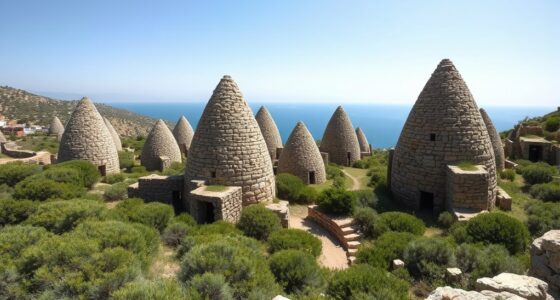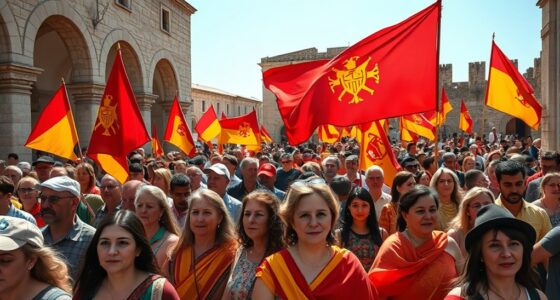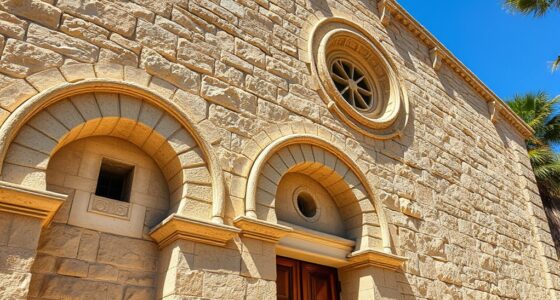When visiting the Necropolis of Monte Siseri in Sardinia, you’ll explore fascinating Neolithic tombs with vibrant rock art and intricate architecture. The site is set on a gentle hillside, offering a glimpse into ancient Sardinian society and spiritual beliefs. To enjoy your visit, join guided tours, respect fragile structures, and follow marked paths for easier exploration. Staying informed about its history and preservation efforts will deepen your appreciation of this significant archaeological wonder. Keep going to learn more about its secrets and historical importance.
Key Takeaways
- Access the site via the hillside near Putifigari, wearing comfortable shoes for uneven terrain.
- Join guided tours or use audio guides for a detailed understanding of the tomb’s artistic and cultural features.
- Respect fragile decorations by avoiding touching walls or paintings; photography may be restricted.
- Follow marked paths to prevent erosion and ensure safe exploration of the archaeological area.
- Visit during favorable weather conditions to enjoy the site’s natural preservation and scenic views.
Discovering the Site and Its Location
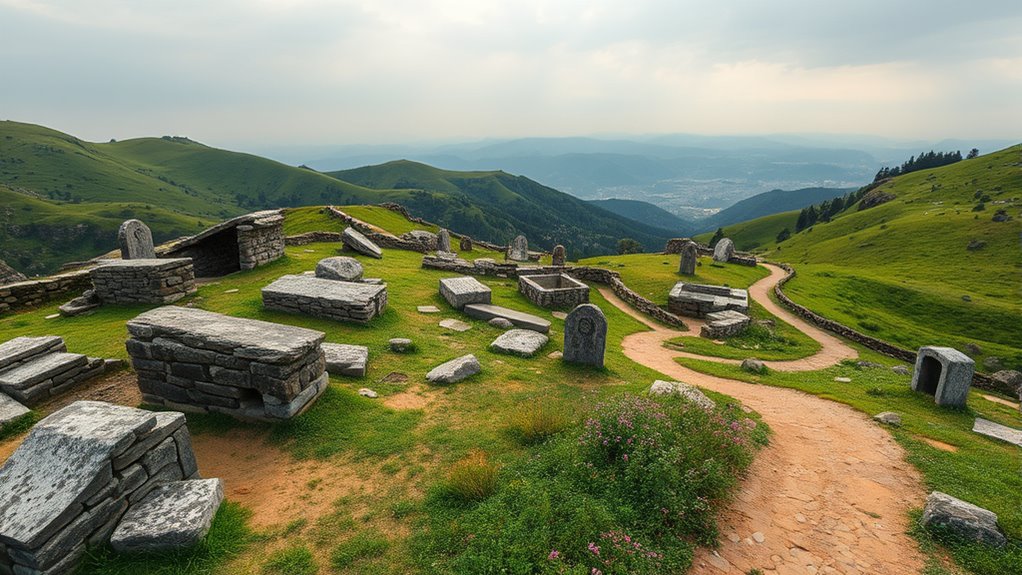
Nestled on the northern slope of Monte Siseri in Putifigari, Sardinia, the Necropolis of Monte Siseri lies within a landscape rich in prehistoric significance. You’ll find it in the Comune of Putifigari, part of the Province of Sassari, in Italy’s Sardinia region. The site sits on a gentle hill, carved into soft pink tuff rock, which made excavation easier. Facing north, it benefits from natural preservation conditions, with the surrounding Mediterranean terrain featuring sparse vegetation. The rock formations resemble symbolic cavities, reminiscent of the maternal womb, adding cultural meaning. Discovered mainly after 1985, the necropolis was excavated by Giovanni Maria Demartis in 1989. Its location connects to a network of Sardinian necropolises, including nearby sites like Crucefissu Mannu, making it a key part of Sardinia’s archaeological landscape. Understanding the geological features of the area helps explain the preservation and significance of the site.
Exploring the Key Tombs and Their Artistic Features
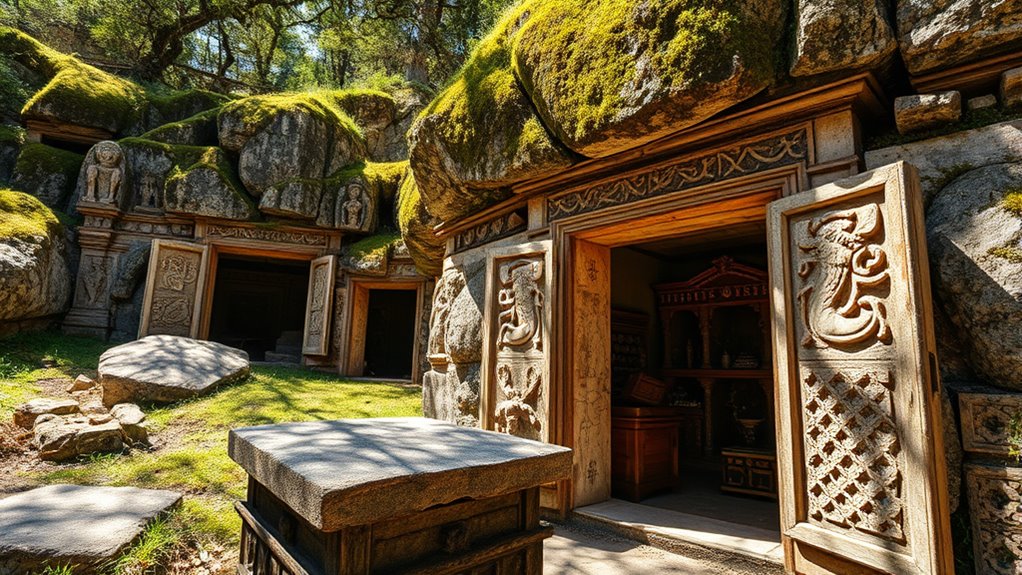
Among the key tombs at Monte Siseri, Tomb I, also known as the S’Incantu or Tomb of Painted Architecture, stands out for its impressive size and artistic complexity. Its architectural features include a dromos, an antechamber, and a main chamber with secondary burial rooms, carved directly into natural rock. The tomb showcases Neolithic art with vibrant colors, detailed decorations, and rich motifs reflecting spiritual beliefs. Architectural elements like columns and doorways are represented through intricate sculptural work, demonstrating advanced craftsmanship. The tomb’s artistic features reveal symbolic and magical-religious significance, emphasizing the importance pre-Nuragic cultures placed on honoring the dead. The use of Neolithic art in the tomb highlights the cultural and ritual importance of these decorations. Despite its age, careful preservation is essential, as natural erosion and human impact threaten its enduring beauty and historical value. The site’s artistic features include elaborate painted motifs and symbolic decorations that highlight its cultural importance.
Understanding the Cultural and Historical Significance

The Necropolis of Monte Siseri holds profound cultural and historical significance because it reveals the development of Sardinian pre-Nuragic societies through its funerary practices and architectural features. Dating from 3200-2600 BCE, it showcases the progression from Neolithic to Copper Age, linked to the Ozieri culture, and reflects long-lasting spiritual traditions, extending into Roman times. The site emphasizes early religious beliefs, with painted motifs and symbolic decorations indicating rituals and ancestor worship. Its elaborate tombs demonstrate social hierarchies and artistic sophistication, fostering regional identity across Sardinia. The unique combination of sculpture, painting, and architecture exemplifies Neolithic artistic achievement. Artifacts preserved from Monte Siseri, now housed in museums, underscore its enduring importance as a crucial link to Sardinia’s prehistoric cultural and spiritual heritage. The site’s rock drawings are among the most impressive in Sardinia, further highlighting its archaeological importance and offering valuable insights into prehistoric symbolic expression. Additionally, the site’s architectural features reveal advanced construction techniques that reflect the technological capabilities of its creators.
Tips for Visiting and Conservation Considerations
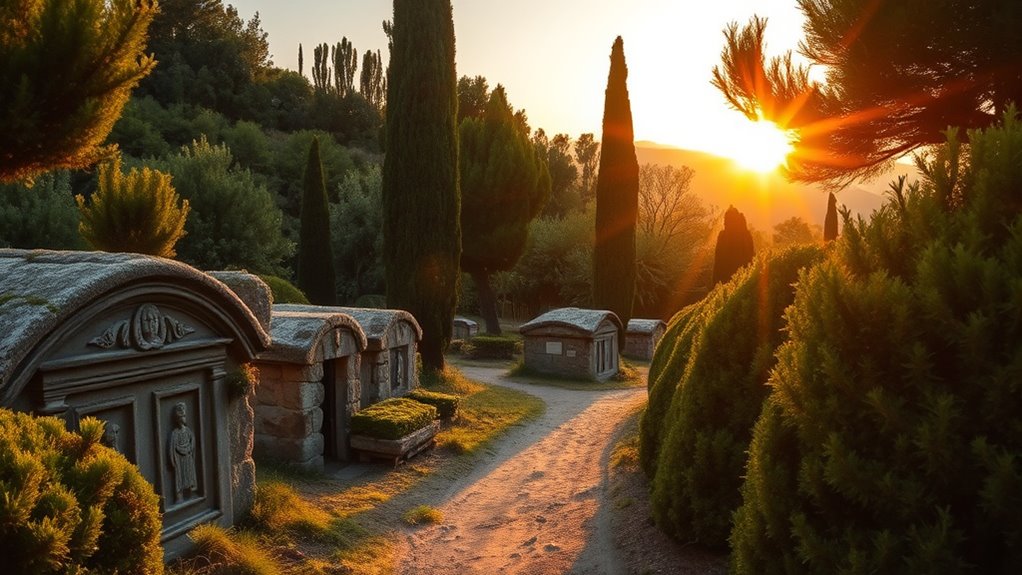
When visiting the Necropolis of Monte Siseri, it’s important to plan ahead and be mindful of the site’s delicate environment. Access is via the slope near Putifigari, and weather conditions can affect your visit since the terrain is natural and hillside-based. To enhance your experience, consider joining guided tours, using audio guides, or reading on-site panels. Respect the fragile architecture and avoid touching walls or paintings to prevent deterioration. Photography might be restricted to protect pigments, and some tombs could be closed for safety. Follow marked paths to prevent erosion, and wear comfortable shoes for uneven terrain. Remember, preserving the site’s integrity guarantees future visitors can appreciate its historical significance. Respect and caution are key to a meaningful, responsible visit. Recognized as a UNESCO World Heritage Site since 2025, it is especially important to protect the site to ensure its longevity for future generations. Engaging with conservation efforts helps maintain its cultural and historical value for years to come.
Insights From Archaeological Research and Preservation Efforts
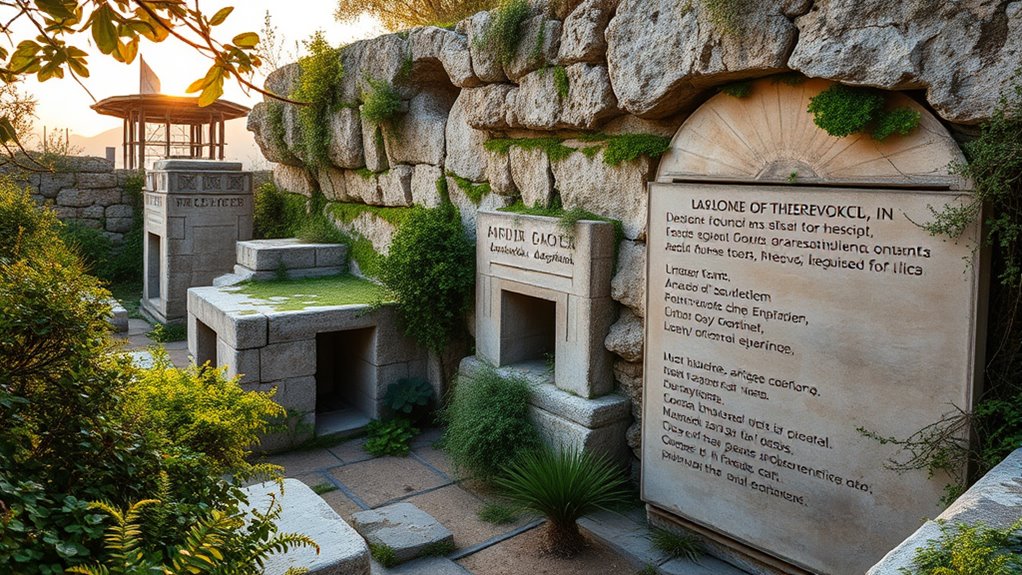
Archaeological research at Monte Siseri has considerably advanced our understanding of its complex history and cultural significance. Since the first systematic study in 1987 and excavation in 1989, researchers identified four stratigraphic layers, revealing artifacts from the Ozieri culture and early Copper Age. These findings show the site’s repeated use from the Recent Neolithic through the Roman era. The “Tomb of Painted Architecture” exemplifies Sardinian Neolithic art with its intricate decorations and symbolic motifs. Preservation efforts focus on safeguarding fragile structures and polychrome paintings, with movable artifacts conserved in regional museums. Documentation, structural reinforcement, and public education initiatives help protect and interpret Monte Siseri’s archaeological heritage, ensuring its significance endures for future generations to study and appreciate. Additionally, employing ethical hacking methodologies in digital preservation can help protect sensitive archaeological data from cyber threats.
Frequently Asked Questions
Are Guided Tours Available at the Necropolis of Monte Siseri?
You’re wondering if guided tours are available at the Necropolis of Monte Siseri. Currently, there’s no specific information confirming guided tours or details about tour operators. You might need to explore independently, as organized visits aren’t documented. To enhance your experience, consider reaching out to local tourism offices or archaeological institutions in Liguria for potential tour options or guided visits to this fascinating site.
What Are the Best Times of Year to Visit the Site?
Imagine stepping into a timeless landscape where seasons paint different moods. You’d enjoy spring’s blooming beauty, ideal for gentle exploration, or the warm glow of autumn’s vivid colors for quiet reflection. Summer offers long days for extended discovery, while winter’s peaceful silence appeals to dedicated scholars. The best time depends on your preferences, but generally, spring and early autumn balance comfortable weather with fewer crowds. Your journey awaits—choose your perfect season.
Is Photography Allowed Inside the Tombs?
You might wonder if photography is permitted inside the tombs. Typically, restrictions are in place to protect delicate wall paintings and structural features, especially in highly sensitive areas like *S’Incantu*. It’s best to follow posted guidelines or ask guides directly, as flash photography and extensive equipment are usually prohibited to prevent damage. Respecting these rules helps preserve the site’s remarkable archaeological and cultural heritage for future visitors.
How Accessible Is the Site for Visitors With Mobility Issues?
Think of the site as a rugged mountain trail—beautiful but challenging. You might find it tough if you have mobility issues, as the tomb’s floors are uneven and involve traversing steps. There are no ramps, handrails, or accessible paths, and natural terrain makes walking difficult. Limited facilities and support mean it’s not very accommodating for visitors with mobility impairments, so plan accordingly to guarantee a safe, enjoyable visit.
Are There Any Visitor Facilities or Interpretive Centers Nearby?
You might wonder if there are visitor facilities or interpretive centers nearby. Currently, the site offers limited amenities, mainly self-guided exploration of the tombs, with no dedicated interpretive centers or guided tours. While nearby towns provide basic services, specialized facilities for visitors aren’t available at Monte Siseri. However, its UNESCO status could lead to future improvements, making it more educational and accessible for visitors seeking interpretive resources.
Conclusion
Visiting the necropolis of Monte Siseri offers a glimpse into a rich past filled with artistry and history. As you explore its ancient tombs, you can’t help but wonder what stories lie beneath those silent stones. Will you be the one to uncover more secrets of this remarkable site? With every step, you become part of a ongoing story of preservation and discovery—so why not step into the past and help keep its memory alive?


